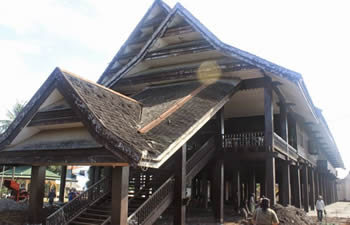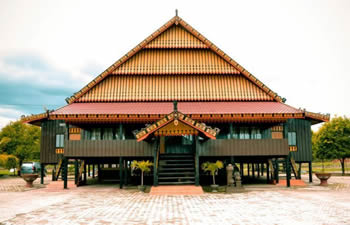South East Sulawesi Wooden Houses
Laika's house is a residence in the Tolaki tribe [1]. Southeast Sulawesi. The population of Southeast Sulawesi consists of several tribes, namely the Tolaki, Buton (Wolio), Muna, Mekongga, and Kaba Ena. On the island of Kaba Ena, the people are generally Muslim. Residential houses in the Tolaki tribe are called Laika (Konawe) and Raha (Mekongga) which means house. Universally, the dwelling house among the Tolaki ethnic groups is called Laika (Konawe) and Raha (Mekongga). This building is spacious, large, and has a rectangular shape made of wood with a roof and stands on large pillars about 20 feet above the ground. The building is located in an open space in the forest surrounded by alang-alang grass. At that time the building was about 60-70 feet high. Used as a place for the king to hold ceremonial events or traditional ceremonies.
Seen horizontally the front of the house is symmetrical, related to the formal shape. Meanwhile, asymmetry is related to dynamic. This meaning is related to the dynamic and formal nature of the Tolaki people. The view from the front or called the lower facade or frame and floor is analogous to the chest and stomach of a human. The attic or upper part is analogous to the human back, while the support is analogous to the human backbone. While the roof is hair or feathers. The roof is analogous to the human face and pelvis.
Viewed vertically, the house of the Tolaki tribe, namely Laika, can be divided into 3 parts, namely.
1. The lower part or under the meaning of the underworld (puriwuta). The function of this section underneath is to avoid wild animals, avoid flooding, can also be used as a place to relax, a place for livestock, or a place to store agricultural tools.
2. The upper part functions as a place of activity.
3. The middle part represents the middle world as the embodiment of the universe.
Seen horizontally the front of the house is symmetrical, related to the formal shape. Meanwhile, asymmetry is related to dynamic. This meaning is related to the dynamic and formal nature of the Tolaki people. The view from the front or called the lower facade or frame and floor is analogous to the chest and stomach of a human. The attic or upper part is analogous to the human back, while the support is analogous to the human backbone. While the roof is hair or feathers. The roof is analogous to the human face and pelvis.
The traditional Tolaki building is a colonnaded building, which is a rounded house pole and for a wooden house (kataba) the pillars are in the shape of a block (rectangular). The main pillar of tusa I'tonga or tusa petumbu is located right in the middle of the house which is the main pillar or pillar of the king. Tusa huno is a pillar found on the four corners of the main house (botono), which is the main pillar of the house. This pole must not be continued, it must be intact to the extent that the pole is closed, the poles are located between one pillar and the other is called a totoro (support pole) which is called o'suda (Posudo). The number of poles in the Mekongga area and in Konawe was adjusted to the shape of the house.
a. Parumbaru, 9 poles
b. Raha Mbuu, 25 poles
c. Raha Bokeo, (the house of the king Mekongga poles totaling 27 and 70 pieces)
Before the Ohoro (floor) was installed there were several arrangements under the floor, namely; Powuatako, wood that is attached to the bottom as a place for installing the Ohoroi (floor). Consists of logs or blocks. Then the Porumbuhi is placed longitudinally, then the sumakiataua polandangi (rather rarely installed), after that just installed the Ohoro (floor) made of bamboo (kowuna), areca sticks (kuwe inea), Opisi (a kind of areca tree), boards (odopi), wood -small wood, sago leaf stalk (Tangge ndawaro).
The walls of the house are generally made of plaited (salabi) or arranged bamboo, small woods, sago stalks (Tangge ndawaro), bark and boards. The wall here is analogous to skin because it is the outermost part of a house, namely the house is considered an analogue of the human body. The form of wall installation (orini) on the Tolaki traditional house (laika mbuu, laika sara) if the roof is tilted, the wall is slanted about 15 degrees. The walls are in the form of salabi sinolana, there are several kinds of sinolanaya models, namely Solana two sheets and Solana three sheets, from which the Solana pinemata-mata (eye shape), pinerde (central form), and pinehiku (elbow shape) appear. In Salabi Sinola it is used to cover the insert hole (powire)
The ladder consists of logs drawn from several levels (usually 5 (five) to 7 (seven) levels) according to the height of the house. In general, the stairs face a public road. Round or flat pillars. According to the tradition of the odd number of rungs, even numbers are not good. Odd numbers are called konanggoa, which means it is very good to get continuous luck and there will be no odd tones in the house. The left and right of the ladder are sometimes given the hand of the ladder and attached with ropes, which are generally made of rattan. The distance between the steps according to the custom is about one cubit or aso elbow. The number of steps indicates the position of the owner. Anakia has 7 (seven) steps. Abdi or Ata has 5 (five) steps. While slaves who were freed had 4 (four) steps. There are 7 (seven) levels of the Raha Bokeo (king's house) ladder, this illustrates the number of regional governments. Whereas in Laika Mbu'u (main house) / Laika aha (big house) in Mekongga, the number must be odd. Odd numbers are considered good because they have elements that cannot be paired with each other to position one another, but one element can affect two other elements which may be competing. Even numbers are considered unfavorable because the elements can divide into two pairs or become one on one which can create a split.
Used as a radiation and enemy stalking place. At Laika Mbu'u there are 6-7 window holes. The houses of the Tolaki people are 4 (four) holes which are analogous to the two o'biri ear elements and two axillary totopa elements. According to Tolaki's belief in placing the windows (competitions) are placed in the direction of the rising sun and setting. Belief in the flow of upstream and downstream rivers is like luck.
Please feel free to contact us +62819 4492 9999  /whatsapp, if you need any information, We would be glad to giving you the assistance as you required.
/whatsapp, if you need any information, We would be glad to giving you the assistance as you required.




